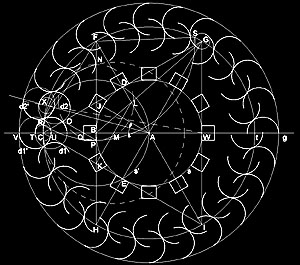
|
s
t a t i o n F
/ g e o m e t r
y
|

|
s
t a t i o n F
/ g e o m e t r
y
|
| by Hofstetter Kurt, 2001 |
 |
| The
geometry of interpenetration - achieved by 2 circles, which are translated
parallel by their radii - formulates a specific transition between inner
and outer space; outside turns inside and inside outside *1). 24 pairs
of half-cylindrical panels, translated by the radii of their semi-circular
cross sections towards the center, are setup in a circle and form the entries
from all directions. The requirement to optimize the light situation in
the pavilion for the screens yields the premise: “No direct light beam
is allowed to enter the inner space“. Therefore the adjacent panels have
to touch each other. The optimization of their semi-circular cross sections
is directly derived from the principle of the Golden Section and can easily
be constructed by only using a set of compasses and a ruler:
Let
A be the mid-point of the pavilion, g the base line through A. The circle
s with center A is translated parallel by its radius AB towards B and yields
the circle s’ with radius BC (interpenetration s, s’); s intersects s’
at D and E; the circle t with radius AC intersects the line through AD
at F and I, the line through AE at G and H; CGI is a equilateral triangle
with inscribed circle s and circumscribed circle t. FH intersects CG at
J and CI at K; From JC=JF=JA=JK=KC=KH=KA results: CKJ is a equilateral
triangle with height BC. BG intersects AF at L and LK intersects AB at
M. The arc with mid-point M and radius MC intersects FH at N; the arc with
center J and radius JN intersects FH at P and CD at O;
* AV is the outer radius of the pavilion. BQ is the depth and BP half the length of the monitor case. To experience the discrete circle of 12 monitors, directed towards the center, in an intimate space, the distance between two opposite screens has been fixed at 6 m, i.e. AB = 3m. According to the Golden Section, described above, the optimal diameter of the pavilion is 14,70 m and the width of each monitor case 82 cm; the line through XW defines the exact length of the half-cylindrical panels by intersecting the interpenetrating circles d2 and d2’, resulting an adequate width for the entries (111cm on the outside, 80cm on the inside). *1)
see Paul Klee, “Zur räumlich körperlichen Durchdringung“
|